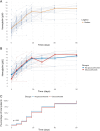Cold Agglutinin Syndrome Secondary to Mycoplasma pneumoniae Infection in Adults: Results From a Large French Observational Study (MyCOLD Study)
- PMID: 40682504
- PMCID: PMC12326233
- DOI: 10.1002/ajh.70010
Cold Agglutinin Syndrome Secondary to Mycoplasma pneumoniae Infection in Adults: Results From a Large French Observational Study (MyCOLD Study)
Abstract
Mycoplasma pneumoniae (MP), primarily a respiratory pathogen, can cause extra-pulmonary manifestations including cold agglutinin syndrome (CAS). We conducted a national, multicenter, observational, ambispective study to describe the characteristics, risk factors, and outcomes of MP-associated CAS. Adult patients hospitalized for a MP-infection with CAS (hemolytic anemia with hemoglobin < 10 g/dL and C3 positive direct anti-globulin test) were included. Recovery was defined as hemoglobin > 10 g/dL off therapy. We also compared MP-infected patients with or without CAS. Sixty patients (51.7% of females; median age of 48.5 years) were included. CAS was diagnosed a median of 10 days after MP-infection symptoms onset. At diagnosis, the median hemoglobin level was 6.9 g/dL, and 71.7% of patients received red blood cell transfusions. Intensive care unit (ICU) admission was required in 45% of patients, and 16.7% experienced a venous thromboembolic event (VTE). Seventeen patients (28.3%) received glucocorticoids alone, while 40 (66.7%) did not receive any specific treatment for CAS. After a median follow-up of 56 (30-83) days, 90% of patients achieved recovery, while 2 patients (3.3%) died from sepsis and pulmonary embolism. Glucocorticoid use did not significantly impact the rate or timing of recovery. Compared with MP-infected patients from the MYCADO cohort study (n = 1267), CAS patients had significantly more VTE (p < 0.0001) and ICU admissions (p = 0.03). MP-associated CAS typically occurs 10 days after the first symptoms of MP infection and is associated with ICU admissions and VTE. Overall, the prognosis of CAS is good, and glucocorticoids do not appear to influence outcomes.
Keywords: Mycoplasma pneumoniae; cold agglutinin syndrome; cold autoimmune hemolytic anemia; glucocorticoids.
© 2025 The Author(s). American Journal of Hematology published by Wiley Periodicals LLC.
Conflict of interest statement
The authors declare no conflicts of interest.
Figures


References
-
- Alexander E. R., Foy H. M., Kenny G. E., et al., “Pneumonia due to <styled-content style="fixed-case"> Mycoplasma pneumoniae </styled-content>. Its Incidence in the Membership of a Co‐Operative Medical Group,” New England Journal of Medicine 275, no. 3 (1966): 131–136. - PubMed
-
- Lenglet A., Herrador Z., Magiorakos A. P., Leitmeyer K., and Coulombier D., “European Working Group on <styled-content style="fixed-case"> Mycoplasma pneumoniae </styled-content> Surveillance. Surveillance Status and Recent Data for <styled-content style="fixed-case"> Mycoplasma pneumoniae </styled-content> Infections in the European Union and European Economic,” Area 17 (2012): 20075. - PubMed
Publication types
MeSH terms
LinkOut - more resources
Full Text Sources
Miscellaneous

